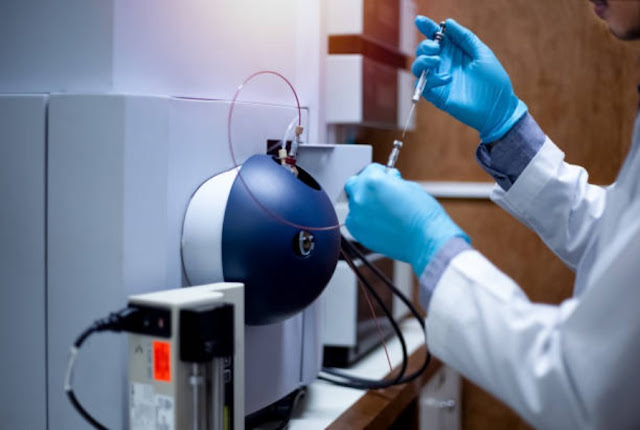Applications of Mass Spectrometry And, More
Mass spectrometry has diverse applications across scientific disciplines:
Proteomics: Mass spectrometry plays a vital role in
proteomics research, allowing the identification and characterization of
proteins. It facilitates the analysis of protein modifications, protein-protein
interactions, and protein quantification. Techniques like liquid
chromatography-mass spectrometry (LC-MS) enable comprehensive proteome
profiling and biomarker discovery.
Metabolomics: Mass spectrometry is used in metabolomics to
study the metabolic profile of biological systems. It allows for identifying
and quantifying small molecules, metabolites, and their transformations.
Metabolomics helps in understanding metabolic pathways, biomarker discovery,
and disease diagnostics.
Drug Discovery and Development: Mass spectrometry is used in
drug discovery and development for drug metabolism studies, pharmacokinetics,
and quantification. It aids in identifying and characterizing drug metabolites,
studying drug-drug interactions, and determining drug stability.
Environmental Analysis: Mass spectrometry is employed in
environmental science to analyze pollutants, contaminants, and environmental
samples. It identifies and quantifies organic compounds, pesticides, and toxins
in air, water, and soil samples. Mass spectrometry is crucial in monitoring
environmental health and ensuring regulatory compliance.
Forensic Science: Mass spectrometry plays a crucial role in
forensic analysis, allowing the identification and analysis of trace evidence,
drugs of abuse, and toxins. It aids in forensic toxicology, arson
investigation, and identification of illicit substances.
Principles of Mass Spectrometry:
Mass spectrometry involves three main steps: ionization,
mass analysis, and detection. The process begins with converting molecules into
ions through various ionization techniques, such as electrospray ionization
(ESI) or atmosphere-abetted laser desorption/ionization (MALDI). These
techniques generate ions with different charge states, allowing for a wide
range of molecules to be analyzed.
Using mass analyzers, the ions are then separated and sorted
based on their mass-to-charge ratio (m/z). Standard mass analyzers include
quadrupole, time-of-flight (TOF), and ion trap analyzers. Each analyzer has its
advantages, such as high-resolution capabilities or enhanced sensitivity.
Finally, the ions are detected, and their abundance is
measured. Detectors, such as electron multipliers or photomultiplier tubes,
convert the ions into electrical signals that computer systems record and
analyze.
Advances in Cancer Research with Virtual Reality
While virtual truth for cancer sufferers has no longer
advanced to the level of a probably healing treatment, it has proven
development in cancer symptom control.
Virtual fact, additionally known as VR, shall we patients engage with a simulated environment thru unique goggles. The tool replaces the consumer’s sight with an imaginary scene.
Some simulations function enjoyable environments inclusive
of a beach with the sound of waves and birds. Others may additionally offer
academic scenes that display how a most cancers patient is diagnosed.
A look at published within the Journal of Cellular
Physiology in 2020 showed that breast cancer patients using VR at the same time
as undergoing chemotherapy showed enhancements of their moods.
The patients had been immersed in scenes related to animals
and nature, in keeping with the examine. These ladies confirmed less anxiety,
melancholy and fatigue than the other girls who have been not uncovered to
virtual truth in the course of remedy.
Researchers say the ones varieties of outcomes display VR
can result in stepped forward mental support for most cancers sufferers as a
palliative treatment, and that might translate to higher survival and best of
life.
Moffitt Cancer Center in Tampa also partnered with Ringling
College of Art and Design in 2020 to create a VR program to help reduce
pressure in most cancers patients, join them to survivor tales and assist them
better apprehend their cancer remedy.
Using Nanotechnology as New Cancer Treatment
The role of nanotechnology in cancer care has centered
totally on using implantable sensors that deliver anticancer remedy with more
precision than traditional methods.
Nanotechnology entails the layout, manufacturing and
application of extraordinarily small gadgets and systems. These gadgets are
usually among one and 900 nanometers in period.
Visualizing how tiny that can be is nearly impossible. But
for comparison, a human fingernail grows one nanometer in line with second. And
a human hair is set a hundred,000 nanometers wide.
In 2022, a studies team at the National Cancer Institute
posted their work on an progressive therapy for pleural mesothelioma the use of
a spray-on hydrogel during surgical operation. The new remedy involves spraying
genetically engineered nanoparticles at the cancer website online to eliminate
mesothelioma tumor cells left in the back of after surgical procedure.
A February 2021 research examine posted in Emergent
Materials proposed the usage of nano-primarily based antimicrobial technology
in non-public device to protect health care people from viral diseases which
includes COVID-19.
Another group of researchers in 2020 evolved a mint-sized
tool to regionally deliver cisplatin, a common chemotherapy drug. The lab
examine discovered the tool’s transport of cisplatin turned into “significantly
poisonous” to breast and liver cancer cells.
At Memorial Sloan Kettering Cancer Center, researchers in
2019 commenced growing a biosensor that may be implanted in the uteruses of
girls at excessive risk of ovarian most cancers.
The intrauterine tool will quick alert doctors if it detects
accelerated, neighborhood ranges of ovarian most cancers biomarkers. If
development of the device is a success, it may enhance early-stage diagnosis
and result in greater personalized treatments.



